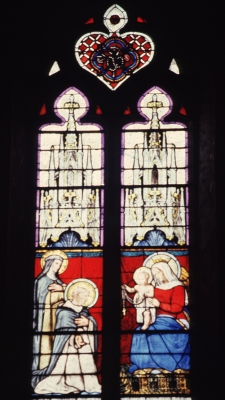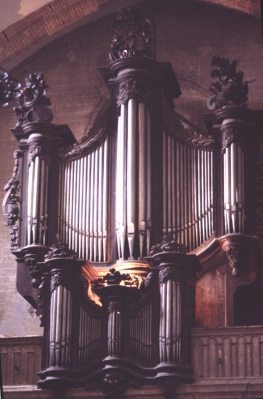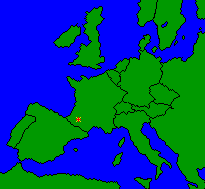Introduction
 The town of Gimont lies some 35 miles West of Toulouse, in the agricultural region between that city and Auch. The present Parish Church was planned in 1292, and the date 1331 appears above the entrance. Built of brick, the church is topped by an octagonal bell tower completed around 1600. The church contains several interesting artifacts, including its altar, a Planselve triptyque of the sixteenth-century, some beautiful windows and the organ. The town of Gimont lies some 35 miles West of Toulouse, in the agricultural region between that city and Auch. The present Parish Church was planned in 1292, and the date 1331 appears above the entrance. Built of brick, the church is topped by an octagonal bell tower completed around 1600. The church contains several interesting artifacts, including its altar, a Planselve triptyque of the sixteenth-century, some beautiful windows and the organ.
 Records show that the church had an organ at least in the early seventeenth century, but the instrument that is there now was built in 1772. In a situation not unlike that found in Dole and Dijon, the Gimont organ was built by a German, Godefroy Schmit. He had worked in Spain, Portugal and other places in France, a cosmopolitan background that is revealed by some of the characteristics of his instruments. Records show that the church had an organ at least in the early seventeenth century, but the instrument that is there now was built in 1772. In a situation not unlike that found in Dole and Dijon, the Gimont organ was built by a German, Godefroy Schmit. He had worked in Spain, Portugal and other places in France, a cosmopolitan background that is revealed by some of the characteristics of his instruments.
In the nineteenth century, a series of renovations, carried out by Jandells in 1836 and by Magen in 1868, "modernized" the organ by replacing its Echo division with a small Romantic Récit and its mutations with a variety of flutes. In 1966, when the organ was unplayable from neglect, a restoration was begun by Patrice Bellet and Jean- Pierre Pajusco. The goal of their work, which was still in progress in 1980 (when I saw the organ), was the return of the instrument to its original disposition. The restoration has since been completed under the direction of Robert Chauvin.
As you can see in the photograph, the case is in many ways typical of French Classical Organs. You see a main case and a smaller Positiv behind it, and in each of the two cases, the façade pipes stand on the same level. The case is somewhat more interesting than many French cases, however, because that line is curved rather than straight.
Disposition
| GRAND ORGUE |
|
POSITIF |
|
ECHO |
|
8
|
|
Montre |
|
8
|
|
Bourdon |
|
|
|
Cornet V |
|
8
|
|
Bourdon |
|
4
|
|
Prestant |
|
|
|
|
|
8
|
|
Dessus de Flûte (c') |
|
2
|
|
Quarte de Nazard |
|
|
|
|
|
4
|
|
Prestant |
|
2
|
|
Doublette |
|
PÉDALE |
|
2 2/3
|
|
Nazard |
|
1 3/5 |
|
Tierce |
|
8
|
|
Flûte |
|
2
|
|
Doublette |
|
|
|
Cornet III |
|
|
|
|
|
1 3/5
|
|
Tierce |
|
|
|
Fourniture |
|
|
|
|
|
|
Grand Cornet |
|
|
|
Cymbale |
|
|
|
|
|
|
Fourniture IV |
|
8
|
|
Cromorne |
|
|
|
|
|
|
Cymbale III |
|
|
|
|
|
|
|
|
|
8
|
|
Trompette |
|
|
|
|
|
|
|
|
|
8
|
|
Voix humaine |
|
|
|
|
|
|
|
|
|
4
|
|
Basses de Clairon |
|
|
|
|
|
|
|
|
|
4
|
|
Dessus de Clairon |
|
|
|
|
|
|
|
|
|
|
|
|
|
|
|
|
|
|
|
Registration Instructions
One of the instresting aspects of this organ is found in a list of registration instructions fastened to a panel on the Positif case.
I copied these instruction down while I was on a tour of European organs sponsored by Westminster Choir College in 1980. The translation is not my own, but I have regrettably forgotten who read this to the group as we headed east out of Toulouse the day after we saw the organ. If you recognize your work here, please let me know so I can give you credit for the translation!
- Plein jeu.
- Registration
- Positif: Montre 4', Bourdon 8', Doublette 2', Fourniture, Cymbale
- Grand Orgue: Montre 8', Bourdon 8', Prestant 4', Doublette 2', Fourniture, Cymbale
- Pedal: Trompette 8'
- Observations
- Jeu for playing the harmony and chant of the church.
- Grand jeu.
- Registration
- Positif: Montre 4', Bourdon 8', Doublette 2', Cromorne 8'
- Grand Orgue: Bourdon 8', Prestant 4', Trompette 8', Clairon 4', Grand Cornet, Doublette 2'
- Pedal: Trompette 8'
- Observations
- Sometimes one uses the Cromorne with the jeu de tierce on the Positif.
- Jeu de tierce
- Registration
- Positif: Montre 4', Bourdon 8', Nazard 2 2/3 Doublette 2', Tierce 1 3/5
- Grand Orgue: Montre 8', Bourdon 8', Prestant 4', Nazard 2 2/3 Doublette 2', Tierce 1 3/5
- Pedal: Flûte 8'
- Observations
- One may sometimes add the Trompette.
- Fond d'orgue
- Registration
- Positif: Montre 4', Bourdon 8'
- Grand Orgue: Montre 8', Bourdon 8', Prestant 4'
- Pedal: Flûte 8'
- Observations
- One plays this on the echo organ from time to time.
- Jeu de symphonie
- Registration
- Positif: Montre 4', Bourdon 8'
- Grand Orgue: Montre 8', Bourdon 8', Voix humaine 8'
- Pedal: Flûte 8'
- Voix humaine
- Registration
- Positif: Montre 4', Bourdon 8'
- Grand Orgue: Montre 8', Bourdon 8', Voix humaine 8'
- Pedal: Flûte 8'
- Observations: A very light combination.
- Récit de Grand Orgue
- Registration
- Positif: Montre 4', Bourdon 8'
- Grand Orgue: Montre 8', Bourdon 8'
- Pedal: Flûte 8'
- Observations
- We use as the Récit the Trompette 8', Clairon 4', Voix humaine 8', Grand Cornet or Basse de Trompette. For the Basse de Trompette one needs the jeu grave with a 16' bass.
- Flute allemande
- Registration
- Indications as for the Récit de Grand orgue.
- Récit du Positif
- Registration
- Positif: Montre 4', Cromorne or Hautbois
- Grand Orgue: Montre 8', Bourdon 8'
- Pédale: Flûte 8'
- Tambourin
- Registration
- Positif: Bourdon 8', Doublette 2'
- Grand Orgue: Montre 8', Bourdon 8'
- Pédale: Flûte 8'
- Observations
- We can play a Récit on any of the stops of the organ except the Fourniture or the Cymbale. Also we can accompany it on the foundations of the Grand orgue or the Positif.
|



